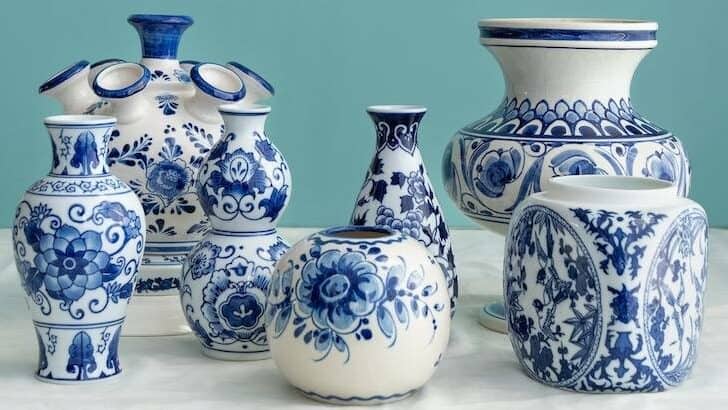Delft pottery has a rich history and it is certainly sought-after among collectors. But exactly how much is delft pottery worth?
The value of delft pottery depends on a number of factors and these affect the price considerably. Some pieces will sell for a few hundred dollars and others will fetch a price in the region of $60,000 or more. Prices range from anything in between these figures.
So, let’s take a look at some of the factors that determine how much Delft pottery is worth. This will give you an idea of how much to pay for an item or how much you can expect to sell a piece of Delft pottery that you own.
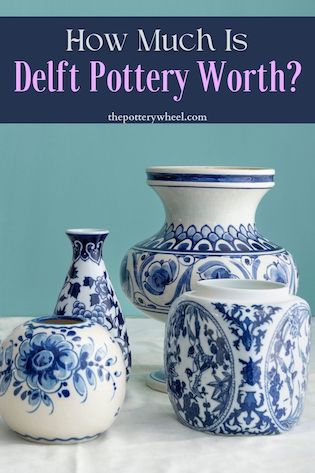
Exactly How Much is Delft Pottery Worth?
Delft pottery, as we think of it today, with its iconic blue and white decoration, started being produced in Delft in the Netherlands in the 17th century. And there are still potteries producing Delftware today
Its production has spanned several centuries. As a result, a lot of Delft pottery has been produced over the years, and it varies hugely in quality. Here are some things to consider when you were trying to put a price tag on your Delftware.
Factor 1 – Is It Antique, Vintage, or Modern?
Although old pottery is not always valuable, the age of an object will affect its price. Generally, older items are rarer and more likely to have an interesting history than modern items. Usually, antique dealers consider items that are over 100 years old to be antique. Vintage items, on the other hand, are often thought to be between 20 and 99 years old (source).
The Value of Antique Delftware
However, interestingly experts in Delft pottery tend to think of antique Delftware as being produced between the late 17 century and early 19 century.
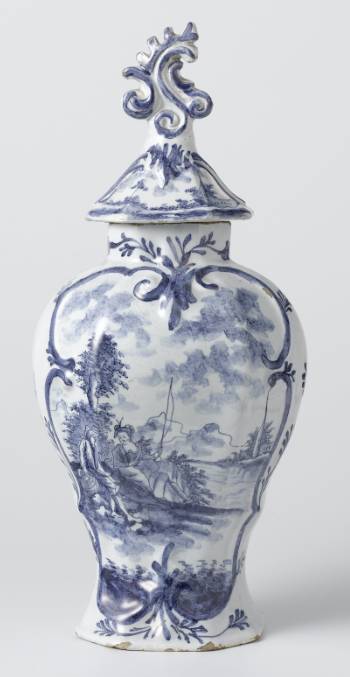
De Porceleyne Byl,
C. 1750-1800. Rijksmuseum.
Public Domain
At the height of its production, there were 33 factories in Delft producing ceramics. Only one of the original factories is still in operation today, it is called the De Porceleyne Fles, also known as The Royal Delft.
The last of the other original factory closed in 1858. So, if you own a piece of Delft pottery that was produced in the first half of the 19th century or earlier, then you can be assured that it was produced by one of the original factories.
This in itself will give the Delft pottery an additional value of its own. It’s not possible to give a single price value for a range of items produced in Delft during this time period.
However, to give you some idea of the price ranges, a Delft plate made during this time period can fetch between $1000 and $5000, with some exceptionally rare pieces fetching more.
The Value of Vintage and Modern Delftware
As stated earlier there are still potteries in Delft today producing ceramics. As well as the Royal Delft, there are other factories also producing high-quality handmade and hand-painted Delftware.
These factories produce a range of items from small decorative trinkets to large multi-layered tulip vases. Accordingly, the prices of these items range from under $100 up to around $20,000.
Antique delftware that is of a higher value is more likely to be for sale at auction houses such as Sotheby’s or Christie’s. However, vintage Delftware that was produced in the last 100 years often comes up for sale on other platforms such as eBay or Etsy.
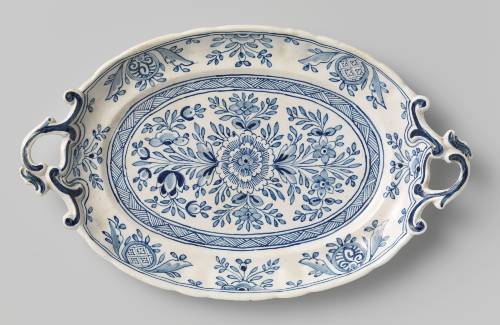
Rijksmuseum, Public Domain
The older a piece of delftware is, the higher the price it is likely to command. From around 1879 De Porceleyne Fles began adding date codes to the ceramics it produced. So, it’s easier from this period to get an exact idea of when a piece was made.
Often, if Delft pottery was produced in the late 19th century or earlier 20th century it will be worth more than something produced more recently.
However, the age of an item is not the only thing that will affect its value. There are other factors to consider as well.
Factor 2 – How Was the Delft Pottery Made?
A lot of Delft pottery has been made over the centuries. At times it has been extremely popular, and with a growth in tourism, there has been a burst in demand from tourists wanting to take away mementos from their trip to the Netherlands.
As a result, in the 20th and 21st centuries, there was a surge in the production of Delft-style ceramics at times using cheaper manufacturing techniques. Therefore, there are lots of pieces of ceramic ware in circulation, that may look like Delft pottery. However, it is in fact worth less than in the Delft pottery made by the original factories.
If you have found a nice-looking piece of ceramics that appears to be Delft pottery, it can be tricky to tell whether it is genuine or not. It’s also hard to estimate its value.
However, luckily there are some features of antique Delft that will help you distinguish it from more modern pieces of ceramic ware. These features are related to how Delftware was originally made until the middle of the 19th century.
Tin Glazing
Up until and including the first half of the 19th century, Delft pottery was produced using a process called Tin glazing.
The glaze on ceramics is the glossy coating that covers the surface of the pottery. Glaze is designed to seal and decorate ceramics. It provides a waterproof barrier and a decorative finish.
The type of glaze used on early Delftware was called tin glaze. This was a lead-based glaze, that contained a small amount of tin oxide. The tin content made the otherwise transparent glaze into an opaque glossy white coating.
The picture below shows a worker at De Porceleyne Fles dipping Delft pottery into tin glaze before being decorated.
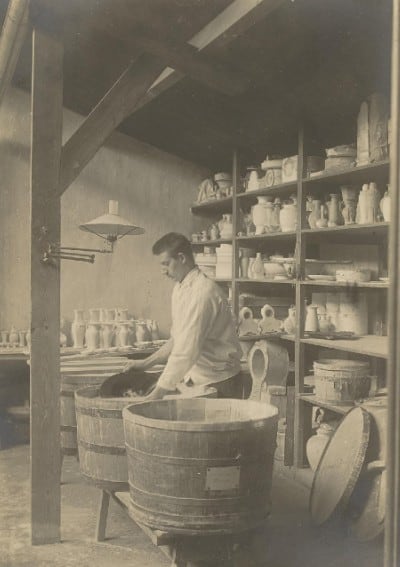
Nationaal Archief, CC0, via Wikimedia Commons
Some of the features that you will find on tin-glazed pottery are…
1) Pinholes:
These are small, usually pin-sized holes in the glaze, generally on the back of a piece of Delft pottery. These holes are produced in the glaze by gases escaping from the clay during the firing process.
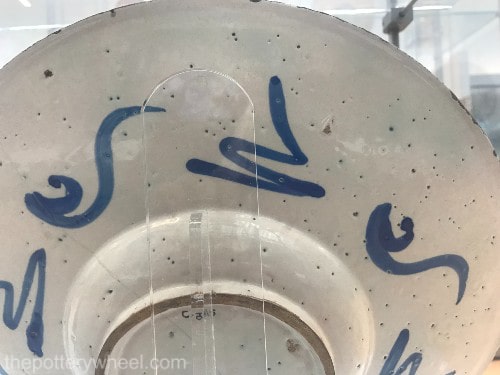
2) Peg marks:
You might find scars in the glaze on the back of a piece of early Delft pottery. When the pottery was being fired, it was supported on small ceramic pegs to stop it from sticking to the kiln shelf.
However, after the kiln had cool down, the supporting pegs needed to be broken off the glazed surface. This left small scars in the glaze. Usually, there will be three peg marks that are equally spaced apart on the base of the plate. These scars do not negatively affect how much the Delft pottery is worth.
3) Yellow clay:
During the period that Delft pottery was being tin-glazed, the factories were using yellow-colored clay. The white tin glaze covered most of the yellow clay.
However, you will see the yellow color of the clay showing through on unglazed areas of the pottery. For example, chips in the glaze will expose the underlying clay body. And if you turn the object over, you will probably see a yellow foot ring.
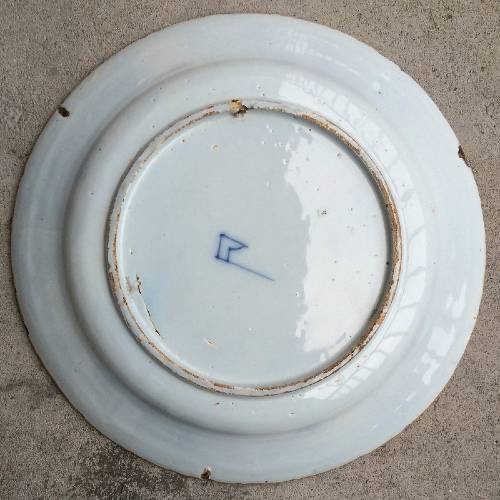
(CC-BY-NC-SA-2.0)
Since the second half of the 19th century, Delft pottery has been made out of white burning clay. This is sometimes coated with a white liquid clay called engobe and then covered with a clear glaze.
Evidence that the pottery was tin-glazed, indicates that the object is probably an antique. As such, it’s more likely to have a higher value.
For example, you might expect a vintage Delft plate to fetch a few hundred dollars, and an antique tin-glazed plate is likely to fetch several hundred dollars. In fact, you will find original tin-glazed Delft plates being sold at auction for between $1000 and $5000.
If you would like to know more about the history of how Delft pottery is made, you can check out my article on that subject here.
Factor 3 – Who Made the Delft Pottery?
Knowing which Delft factory produced a piece of pottery can increase how much it is worth. If a piece of pottery is marked, it can be easier to identify who made it and establish its history.
Having said that, there are many other features of Delftware that can help you identify it, even if it has been left unmarked. If you would like to know more about how to identify unmarked Delft pottery take a look at my article on that subject here.
A lot of early Delft pottery was not signed. Many pieces left the factories unmarked. And whilst pottery markings are helpful to have an understanding of the object, many pieces of unmarked pottery can still be valuable.
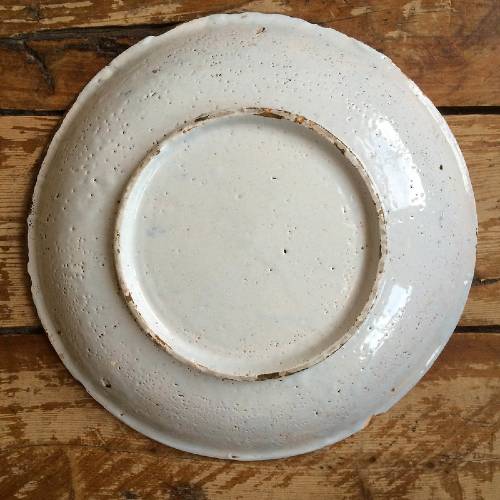
Image by Carl Guderin (CC-BY-NC-SA-2.0)
It’s not uncommon for a piece of unmarked Delftware to sell at prices in the $1000-$5000 range.
Nevertheless, marked pottery has an appeal because it is easier for valuers to ascertain at least some information about it.
It’s not always clear from all Delft pottery marks, which factory actually produced it. Sometimes the marks and numbers are hard to decode. For example, it might be possible to tell from the mark what year the pot was made, but not who made it.
Nevertheless, markings do you often give us some, if not all information about the origins of a piece of pottery. As a result, markings are appealing to buyers, because it gives them a better sense of the historical value of an object.
This historical value is related to what is known as its provenance. Provenance is an important part of valuing artwork, so let’s take a look at the impact that it has on how much Delft pottery is worth.
Factor 4 – The Provenance
Provenance refers to the journey that a piece of artwork has been on throughout this lifetime. It is the journey that the artwork takes from where it was made, and who owned it over the years.
A piece of Delftware with an interesting history will have a higher price when it is sold. One example of this is Delft pyramid vases also known as tulipiere, or tulip vases.
Tulip vases come in different shapes and sizes. However, they each have multiple spouts positioned at different points around the vase. The idea is that tulips or other flowers can be inserted into the spouts all the way around the vase.
Some tulip vases are small and designed to sit on a tabletop. However, others are very large and made up of different sections that can be stacked upon one another. These are called pyramid vases because of their pyramid shape.
The Influence of William and Mary
William III and Mary II were joint monarchs of England in 1689 (source). Although William was Dutch by birth, he reigned England, Scotland, and Ireland until his death in 1702.
He and Mary spent time in the Netherlands and developed a passion for Delft pottery. Mary in particular became a collector of Delft pottery, some of which is still on display at Hampton Court Palace in the UK.
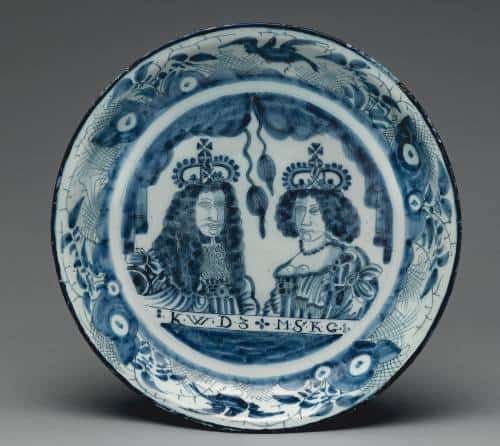
Image courtesy of The Met, Public Domain.
Mary II
As a patron of the “Greek A” factory (De Grieksche A) in Delft, Mary commissioned many pieces of Delftware to be made. These commissions were made whilst the factory was owned by both Samuel van Eenhoorn and also later Adrianus Kocx.
Mary owned a selection of Delft pyramid vases. Some of which she kept at Kensington Palace in London, and some of which she kept at Hampton Court Palace.
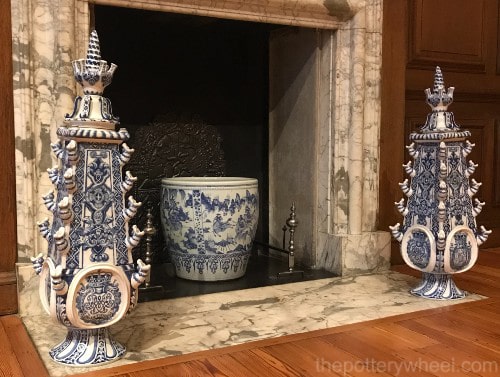
Mary’s passion for these pieces made them fashionable at the time. And also, today when pyramid vases are sold, Mary’s ownership of similar pieces is often cited as being a point of interest and value.
The Delftware for sale does not necessarily need to have been owned by Mary and William, it is enough that the piece is similar to an item that they owned to increase its value.
For example, a pyramid vase sold by Sotheby’s had an estimated value of $35,000-$64,000. Although it was not owned by William and Mary it was described as being similar to other vases ordered by the Duke of Devonshire who was a supporter of William and Mary.
And it was described as being similar to a pyramid vase in a collection at the V&A museum in London (source). This is an indication of how important historical connections can affect the value of a piece of Delft pottery.
Whilst you may not be in possession of a piece of pottery that has been owned by royalty, if you can provide an interesting backstory to the object this may increase its value.
Factor 5 – What Condition is The Delft Pottery in?
Generally speaking, the value of a piece of antique pottery will be reduced if it has sustained some degree of wear and tear or damage. A helpful rule of thumb is that if an object has been damaged, it will be worth about half of its mint condition value (source).
However, there are some exceptions to this rule, and Delft pottery is one of them. Delft pottery is made of earthenware clay rather than porcelain.
Porcelain is very hard and dense, as a result, it does not chip or break readily. By contrast, fired earthenware clay is quite porous and softer than porcelain. As a result, it tends to chip more easily than porcelain.
You will find that most antique or vintage Delft pottery has small chips on the glaze, exposing the yellow earthenware clay underneath. A mint-condition piece of antique Delft pottery may fetch a high value. However, signs of wear and tear will not affect its value in the same way that it might affect the value of for example antique Chinese porcelain.
The plate below from around 1760-1790 made by De Porceleyne Byl shows some typical signs of wear and tear found on Delft pottery.
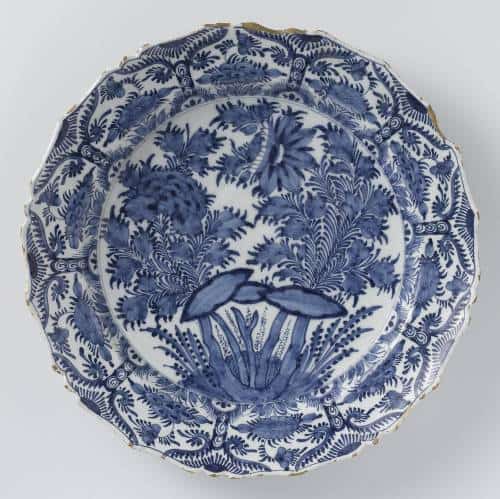
Rijksmuseum. Public Domain
Factor 6 – What is the Object?
The Delft factories made a wide range of items including amongst other things plates, platters, flasks, ornaments, candle sticks, tiles, and vases.
It’s not possible to make generalizations about the price each kind of item will fetch. For example, some Delft pottery plates will sell for a few hundred dollars, whereas others will sell for in excess of $20,000.
Much of the value will be affected by the factors outlined above. However, there is some truth in the idea that the more ornate, complex, and in some cases larger a piece of pottery is, the more valuable it will be.
A good example of this is the tulip vases described earlier on. Tulip vases are made through a process called slip-casting. The main body of the vase is made by pouring liquid clay into a multi-piece plaster mold. Once the mold has been removed, the various parts of the vase are assembled together, and the spouts are attached to the vase individually.
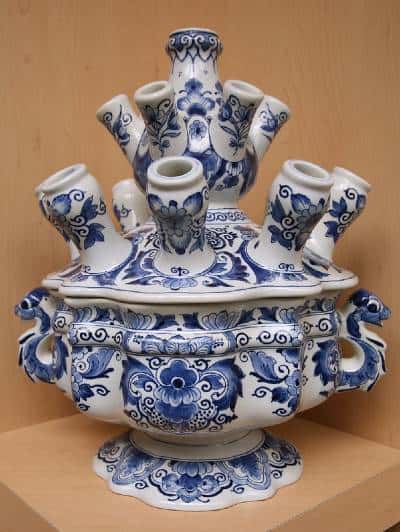
The construction of the vase is a complicated process, and the painting process also involves a high level of craftsmanship. A small tulip vase designed to sit on a tabletop may have around five or six spouts. An antique tulip vase of this size may well sell between $1000 and $2000.
A multi-layered pyramid vase is a much larger and more complex piece of Delftware. They are still being made today by Royal Delft, and a new pyramid vase will cost around $20,000.
By contrast, an antique pyramid vase, as mentioned above can fetch in the region of $50-$70,000.
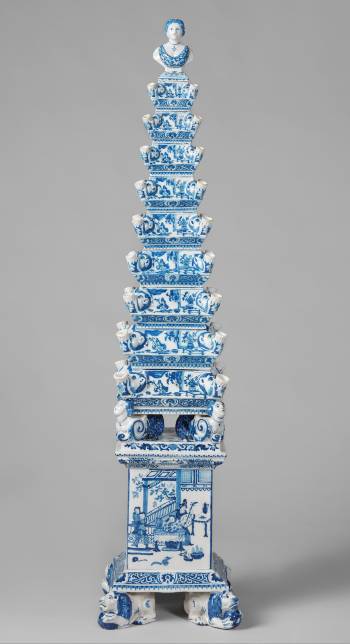
Rijksmuseum. Public Domain.
Factor 7 – Is it Genuine Delftware?
The Delft pottery factories inspired the production of Delft-style ceramics both inside the Netherlands and in other countries. For example, a significant amount of Delft-style pottery was, and still is, made in Amsterdam.
And a good example of Delftware produced outside The Netherlands is English Delft. Delft-style ceramics made in the UK developed a style of their own, which has come to be known as English Delftware.
This was made in Britain between the middle of the 16th century till the late 18th century. The main regions of production were Liverpool, Bristol, and London. English delftware has a particular style of its own, which sometimes reflects English pastoral scenes and themes.
However, some English Delftware does look strikingly similar to Dutch Delftware. So, if you find a piece of pottery in a thrift store or in your attic that looks like Dutch Delft pottery, it’s worth pausing to consider whether it is genuine Delftware, or whether it was made elsewhere.
The delftware tiles in the picture that follows were probably made in London England. They are on display at the V&A museum in London.
There is some uncertainty about where they were made. However, it’s thought that they were made in a London delftware pottery between 1720 and 1730.
It’s known that at least one London pottery sought skilled labor from the Netherlands, and that this accounts for the manufacture of such high quality panels.
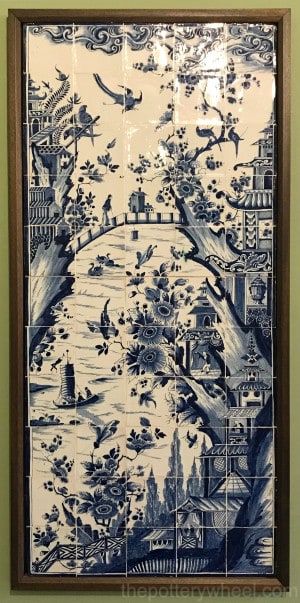
Having said that, English Delftware is valuable and its own right. As you can see below in the section about expensive Delftware pottery, many pieces of English Delft match and sometimes exceed the prices achieved by Dutch Delft pottery.
You can also get an idea of the prices achieved by English Delftware on John Howard’s website called Antique Pottery.
Reproduction Dutch Delft Pottery
During the 19 century many pieces of reproduction Dutch Delftware were made. Some of these reproductions were so convincing that it is hard to distinguish them from original Dutch Delftware.
For example, in 1864 a Frenchman called Edme Samson opened a factory in Montreuil with his son Emile. They made a range of reproduction ceramics from around the world, including reproductions of Dutch Delft.
Reproduction ceramics made by Samson was marked with the letter S, which was designed to distinguish them from the originals they were made in the style of.
However, over the years these reproductions have sometimes been confused with original Dutch Delftware. The ceramics made by Samson were handcrafted and hand-painted. And they have a value of their own. For example, a couple of antique vases produced by Sampson can fetch around $6000.
Another French businessman and designer called Geo Martel made reproduction Delft pottery in the 20th century. His work is catalogued in the book L’Heritage De Delft a Desvres, which was written in conjunction with his granddaughter.
This book researches the techniques that Martel used to replicate the original Dutch Delft earthenware. And it compares the reproductions to the originals that inspired Martel.
Factor 8 – Is It Modern Mass Produced Ceramicware?
As mentioned earlier on, there has been a big growth in tourism during the 20th and 21st centuries. As a result, there has been an increase in the mass production of cheaply produced ceramics in the style of traditional Delft pottery.
Erickson, who wrote the book “Royal Delft: A Guide to De Porceleyne Fles,” refers to this inexpensive ceramic ware as “tourist kitsch.”
Sometimes this pottery will have a signature on the base that looks a little bit similar to some of the original Delft pottery marks. However, most of the time the decorations on these ceramics are printed transfers rather than hand-painted.
Ceramics made in this way is not worth very much in a second-hand marketplace. For example, you can pick up bundles of these Delft-style objects on eBay for around $50.
What is The Most expensive Delft Pottery?
You’re will find the most expensive Delft pottery with the highest worth being sold at top-end auction houses around the world. The following examples of Delft pottery sold at auction will give you an idea of what sought-after pieces are worth.
Sotheby’s
| Item sold: 4 Tiered Tulip Vase, circa 1700 Date of auction: 24th January 2022 Price: $47,880 |
| Item sold: Dutch Delft blue and white charger, dated 1730 Date of auction: 23rd January 2022 Price: $31,500 |
| Item sold: Collection of Dutch Delft blue and white tiles, 19th century Date of auction: 23rd January 2022 Price: $21,420 |
Christie’s
| Item sold: Dutch Delft blue and white sectional flower vase circa 1695 to 1700, De Grieksche A Factory Date of auction: 18th June 2008 Price: £73,250 ($89,000) |
| Item sold: An English Delft charger with a portrait of Charles II, dated 1662 Date of auction: 26th January 2010 Price: $170,500 |
| Item sold: A London Delft blue and white candlestick, 1653 Date of auction: 24th of January 2011 Price: $146,500 |
Bonhams
| Item sold: A rare Dutch Delft basin De Grieksche A Factory, 1686 to 1701 Date of auction: 9th of December 2021 Price: £25,250 ($30,700) |
Cottone Auctions
| Item sold: Early Delft charger with polychrome rooster decoration Date of auction: 5th of October 2013 Price: $25,875 |
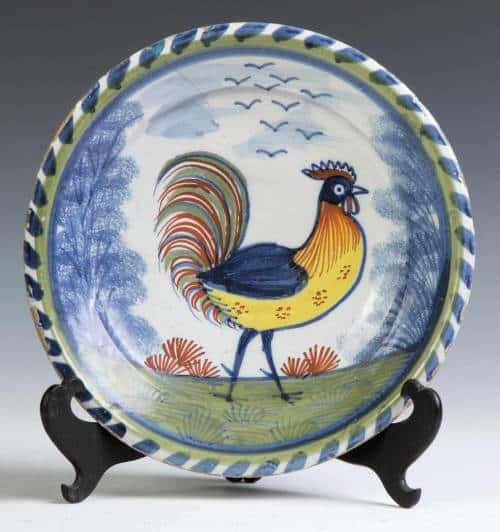
Final Thoughts
The value of Delft pottery ranges from moderately priced items for sale on platforms such as eBay to high-ticket items for sale at top-end auction houses. Therefore, figuring out how much your Delft pottery is worth might involve a little investigation and research. That being said, the monetary value is possibly not as important as the enjoyment they bring. As Oscar Wilde said, a cynic is somebody who “knows the price of everything and the value of nothing”.

